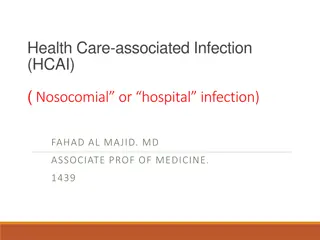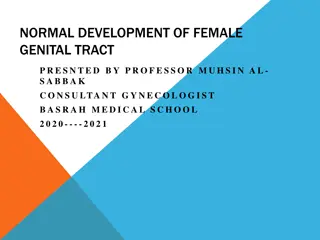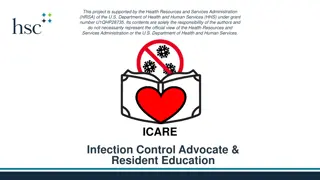Understanding Female Reproductive Infections and Inflammations
Female reproductive system infections such as Pelvic Inflammatory Disease (PID), Vaginitis, Cervicitis, Endometritis, and Salpingitis can lead to various symptoms and complications. These conditions are caused by different factors including infections, bacterial imbalances, and sexually transmitted organisms. Recognizing the symptoms and seeking prompt medical attention is crucial for proper diagnosis and treatment.
Download Presentation

Please find below an Image/Link to download the presentation.
The content on the website is provided AS IS for your information and personal use only. It may not be sold, licensed, or shared on other websites without obtaining consent from the author. Download presentation by click this link. If you encounter any issues during the download, it is possible that the publisher has removed the file from their server.
E N D
Presentation Transcript
Pelvic inflammatory disease prof. Dr. Rabea M. Ali
Pelvic inflammatory disease (PID) is an infection of the female reproductive organs. It most often occurs when sexually transmitted bacteria spread from the vagina to the uterus,fallopian tubes or ovaries Pelvic inflammatory disease (PID) is a clinical syndrome that results from the ascension of microorganisms from the cervix and vagina to the upper genital tract.
Vaginitis, also known as vulvovaginitis, is inflammation of the vagina and vulva Symptoms itching burning pain The three main causes are infections, specifically bacterial vaginosis, vaginal yeast infection, and trichomoniasis. Other causes include allergies to substances such as spermicides or soaps or as a result of low estrogen levels during breast- feeding or after menopause.
Cervicitis is inflammation of the uterine cervix Symptoms Abnormal vaginal bleeding after intercourse between periods Unusual gray, white, or yellow vaginal discharge Painful sexual intercourse Pain in the vagina Pressure or heaviness in the pelvis Cervicitis can be caused by any of a number of infections, of which the most common are chlamydia and gonorrhea
Endometritis is inflammation of the inner lining of the uterus (endometrium) Symptoms 1. fever 2. lower abdominal pain 3. abnormal vaginal bleeding or discharge Risk factors for Endometritis following delivery include Caesarean section and prolonged rupture of membranes
Salpingitis is an infection and inflammation in the Fallopian tubes (salpinges). Symptoms 1. Abnormal smell and colour of vaginal discharge 2. Pain during ovulation 3. Pain during sexual intercourse 4. Abdominal pain 5. Lower back pain 6. Fever 7. Nausea 8. Vomiting 9. Bloating
Oophoritis is an inflammation of the ovaries. It is often with salpingitis (inflammation of the fallopian tubes). seen in combination Symptoms 1. Abdominal pain 2. Pelvic pain 3. Vaginal discharge 4. Dyspareunia 5. Fever 6. Chills 7. Nausea/vomiting
Peritonitis is inflammation of the peritoneum, the lining of the inner wall of the abdomen and cover of the abdominal organs Symptoms 1. Diffuse abdominal rigidity ("abdominal guarding") is often present, especially in generalized peritonitis 2. Fever 3. Development of ileus paralyticus (i.e., intestinal paralysis), which also causes nausea,vomiting and 4. bloating. 5. Reduced or no passage of abdominal gas and bowel sound
Approximately one million women are diagnosed yearly It is the most common serious STD complication . Acute PID is commonly caused by Chlamydia and Gonorrhea
Types Subclinical disease (asymptomatic), which is thought to be present 60% of the time, is notable because it lacks symptoms. This makes diagnosis and treatment problematic. Women may experience dyspareunia, irregular bleeding, dysuria, or gastrointestinal symptoms, which they may not link to PID,and therefore,may not seek care.
Acute PID is when there is sudden or severe inflammation of the uterus, fallopian tubes, ovaries and pelvic area due to infection. Sometimes the inflammation can persist for a long time; this is known as chronic pelvic inflammatory disease (see Are there any long-term effects?).
Mild to moderate PID, women may complain of lower abdominal pain or pelvic pain, cramping, or dysuria. They may also exhibit signs such as intermittent or post-coital bleeding, vaginal discharge, or fever. Uterine tenderness or cervical motion pain or adnexal tenderness is most often present on pelvic exam in most cases of moderate PID.
Severe PID, women appear very ill with fever, chills, purulent vaginal discharge,nausea,vomiting,and elevated white blood cell count (WBC). Other laboratory indicators, such as erythrocyte sedimentation rate (ESR) and C-reactive protein (CRP),may also be elevated.
SYMPTOMS 1. Pain ranging from mild to severe in your lower abdomen and pelvis 2. Abnormal or heavy vaginal discharge that may have an unpleasant odor 3. Abnormal uterine bleeding, especially during or after intercourse, or between menstrual cycles 4. Pain during intercourse 5. Fever, sometimes with chills 6. Painful, frequent or difficult urination
Pathophysiology Pelvic inflammatory disease (PID) is an infection of the female reproductive organs. It usually occurs when sexually transmitted bacteria spread from the vagina to the uterus, fallopian tubes or ovaries. Many women who develop pelvic inflammatory disease either experience no signs or symptoms or don't seek treatment.
CAUSES 1. Bacteria such as : gonorrhea or chlamydia infections are the most common. 2. These bacteria are unprotected sex. 3. Less commonly, during menstruation bacteria can enter the reproductive tract 4. and after childbirth,miscarriage or abortion. 5. Rarely, bacteria can also enter the reproductive tract during the insertion of an intrauterine device (IUD) a form of long-term birth control. usually acquired during
Risk factors Being a sexually active woman younger than 25 years old Having multiple sexual partners Being in a sexual relationship with a person who has more than one sex partner Having sex without a condom Having a history of pelvic inflammatory disease or a sexually transmitted infection
Diagnosing PID Tests may include: 1. pelvic exam to check your pelvic organs 2. cervical culture to check your cervix for infections 3. urine test to check your urine for signs of blood, cancer, and other diseases 4. Pelvic ultrasound. This is an imaging test that uses sound waves to create pictures of your internal organs. 5. Endometrial biopsy. In this outpatient procedure a doctor removes and examines a small sample from the lining of your uterus. 6. Laparoscopy. A laparoscopy is an outpatient procedure where a doctor inserts a flexible instrument through an incision in your abdomen and takes pictures of your pelvic organs
Treatment Outpatient: 1. Ceftriaxone 250 mg IM x 1 2. Doxycycline 100 mg PO BID x 14 days 3. Metronidazole 500 mg PO BID x 14 days 4. Ofloxacin 400 mg PO BID x 14 days or Levofloxacin 400 QD x 14 days Plus Metronidazole 500 mg PO BID x 14 days 5. Treatment for partner.To prevent reinfection with an STI , sexual partner or partners should be examined and treated..
Criteria of hospitalization surgical emergencies (e.g., appendicitis) cannot be excluded; Tubo-ovarian abscess Surgical treatment may involve unilateral salpingo-oophorectomy or hysterectomy and bilateral salpingo-oophorectomy. Ideally, the operation is performed after the acute infection and inflammation have resolved. In patients with recurrent PID, dense pelvic adhesions may render surgery difficult.
Long term complications 1. infertility,an inability to conceive a child 2. ectopic pregnancy, a pregnancy that occurs outside the womb 3. chronic pelvic pain, pain in the lower abdomen caused by scarring of the fallopian tubes and other pelvic organs 4. Salpingitis, if the infection spreads to the fallopian tube that makes it difficult to transmit the ovaries to the womb.
Prevention 1.practicing safe sex 2.getting tested for sexually transmitted infections 3.avoiding douches 4.wiping from front to back after using the bathroom to stop bacteria from entering your vagina























